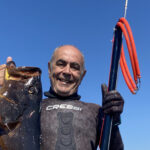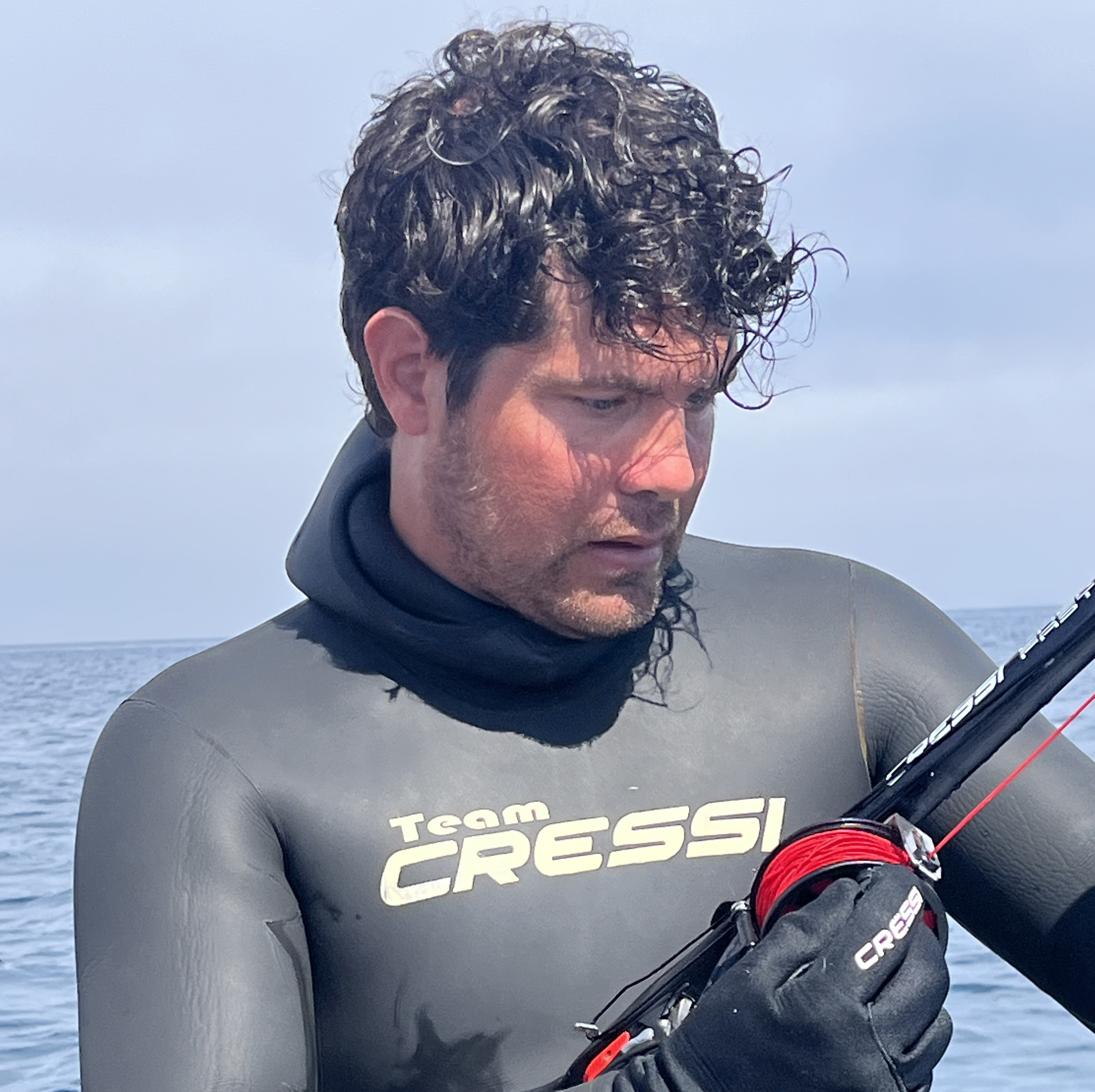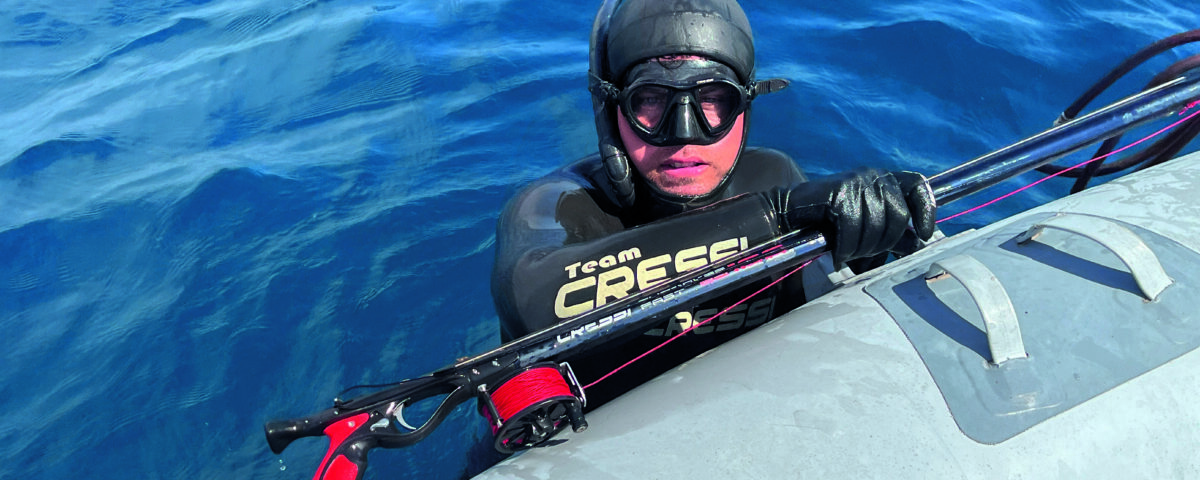Puretti’s Corner

Up Close: Nino Piras
29 July 2025
Simona Auteri: the Freediver with a thousand interests
1 August 2025There’s a word—“feeling”—that is too often underestimated when buying a speargun. This is because performance is usually evaluated “on paper”: how far it shoots, its power, the type of shaft... while the bond, the familiarity with the weapon itself is wrongly overlooked. Without that connection, even the best model in the world becomes useless. It’s like buying a supercar and not knowing how to drive it! That’s why my advice is to get in the water as much as possible: shoot, shoot, and shoot again. Only then will your speargun—whether it’s a band gun or pneumatic—become an extension of your body and your will
Luigi Puretti
In last month’s article, I aimed to compare the different propulsion systems in a very technical, almost scientific way. For those who didn’t catch the point, let me clarify: the goal was not to prove which speargun is the best, but to determine which propulsion system is most efficient, by calculating shaft speed and kinetic energy at the target. But beyond range, assessing the quality of a speargun also requires looking at a long list of additional parameters such as length, trim, reliability, cost, maneuverability, recoil, and accuracy.
I believe that it’s possible to objectively evaluate these parameters through longer, more complex comparative tests—though, to be honest, most people probably wouldn’t be interested. However, when evaluating any weapon, even on land, two important factors are often underestimated: the feeling, and the suitability of the gun to the context in which it will be used.
The Importance of Feeling
In the world of gear—especially among spearfishing enthusiasts—there’s a constant talk about bands, shafts, and the latest speargun models. The search for the “perfect setup” is a never-ending pursuit, almost an instinct. Yet, there’s one intangible element, often overlooked, that actually makes the difference between a good spearfisher and an exceptional one: the feeling with your weapon.
It’s not just about holding a piece of plastic, carbon, or wood; it’s about creating a deep, almost symbiotic connection, where the gear becomes an extension of your body and your intent.
Think of a virtuoso musician: it’s not the most expensive violin that makes him great, but his ability to make it “sing”, to understand every nuance, every limit. In the same way, a skilled spearfisher doesn’t rely blindly on a speargun’s specs. Instead, they develop an intimate knowledge—a silent dialogue—with their weapon.
Every model, even mass-produced ones, has its own “soul”, its own quirks. The weight, the balance, the trigger sensitivity, the recoil—these are all elements that, though measurable, are perceived and interpreted uniquely by each spearfisher.
A top-of-the-line speargun packed with cutting-edge tech may offer an advantage at first, but without feeling, that tech remains unrealized potential. It’s like owning a Ferrari and not knowing how to drive it.
Feeling, instead, is that sense of familiarity that allows you to anticipate the gun’s behavior, to manage recoil naturally, to feel the trigger “click” almost before it actually does.
But how is that bond developed? Let’s be clear—it’s not magic. It’s the result of practice and attention. Let me break it down:
Physical Contact
It all starts with the grip. The gun must fit like a glove. Your strong hand should naturally find the optimal grip point, and your index finger should rest on the trigger effortlessly. Even small tweaks—like adding a cheek pad or a custom handle—can make a world of difference.
Muscle Memory
Feeling is built through repetition. Every time you shoulder the gun, aim, and shoot, you reinforce muscle memory. Movements become fluid—almost automatic. You no longer think about what to do. You just do it. And that’s the key to consistent shooting.
Listening
Every gun “talks” to the shooter. The sound of the bands contracting, the vibration after firing, the sensation of recoil—all these signals carry information. Learning to interpret them helps you improve your technique or spot issues. Too much recoil? Maybe your posture is off. Inconsistent shots? Could be your grip.
Psychological Confidence
A crucial part of feeling is trust. When you trust your gun—when you know it will “respond” the way you want—your tension fades. Doubts and second-guessing disappear, allowing full concentration on the target and technique. That mutual trust between shooter and weapon is the real secret to precision.
I don’t know if it’s ever happened to you, but it’s something I’ve experienced more than once in my career. After missing a couple of important shots, I started losing trust in my speargun. Before pulling the trigger, I hesitated. This led to even more inaccurate shots and a cascade of doubts. Then, after nailing four or five perfect hits, my confidence came back. But in reality, nothing had changed in the speargun itself.
Precision Comes From Connection, Not Cost
How many times do you see spearfishers with top-tier gear delivering mediocre results, while others, with older or more modest equipment, land incredible catches?
Almost always, the difference lies in the bond.
The spearfisher who’s spent countless hours in the water with their weapon, who knows every nuance, who’s adjusted their posture and technique to match that specific gun, will always have the upper hand.
Investing in a high-end speargun without committing time and effort to learn and master it is like buying a grand piano and expecting to play like a concert pianist without ever taking lessons.
The best speargun in the world, in the wrong hands—or without feeling—is just an inert object.
But in the hands of someone who “feels” it, even a basic speargun becomes a tool of extraordinary precision.
In the end, the quest for precision isn’t just about choosing the “best” speargun. It’s a much more personal and intimate journey—one of discovery and adaptation, where shooter and weapon move together in harmony.
The gun is the instrument, but the melody of precision comes from connection, confidence, and above all, that indescribable feeling that transforms a simple object into an extension of your will.
So, next time you’re evaluating a new speargun, don’t just ask yourself how accurate it is on paper—ask yourself how in sync you feel with it. That will be the real key to landing accurate shots.
How to Choose the Right Speargun
During my courses or training sessions, I tend to divide spearfishers into four main categories:
- “I can’t see anything.”
- “I see some fish but can’t get close.”
- “I catch fish occasionally or by chance.”
- “I consistently land good fish.”
When we get to the gear section, I always say that a good spearfisher has two great skills:
- The ability to find fish.
- The ability to use the right speargun for the expected scenario.
All of this, of course, is aimed at maximizing efficiency, or in other words, increasing your chances of making a successful catch based on the types of encounters you expect.
Of course, nothing stops you from jumping in the water with a cannon every time, sacrificing smaller catches in hopes of landing the fish of a lifetime.
To keep it short: the best speargun does exist, and it’s simply the one that best harmonizes with the environmental conditions, the technique used, and the target species.
For beginners or those diving in tight spaces, a 75 cm single-band gun with a 6 to 6.5 mm shaft remains ideal.
It’s short enough for quick maneuvering, perfect for squeezing into crevices, turning rapidly, and taking accurate close-range shots.
Great for hunting wrasse, scorpionfish, conger eels, moray eels, and holed-up sea bream. Its responsiveness also makes it suitable for mixed terrain—rocky and sandy areas—where shots are often fast and close. It’s easy to load and powerful enough without the risk of damaging or jamming the shaft on close shots.
Now let me share the other sizes in my small “arsenal”:
- For cave fishing, I often use a 55/60 with a trident tip. In competitions, a shorter pneumatic with trident, or a 60 cm single-band with tahitian shaft is a must for tight spaces.
- After the 75, I move to 90 cm and 100 cm models, which I consider versatile all-rounders.
Especially the 100 cm with double 14 mm bands—perfect for a wide range of conditions and fish, from deep diving to easier grounds. It’s often my go-to when arriving at a new spot. - Over the years, I’ve always had a “cannon” in the lineup. Right now, that’s a 130 cm triple-band gun with a 7.5 mm shaft.
Every spearfisher has their preferences, but one thing’s for sure: you’ll always find a cannon in their bag.
After feedback from friends and testing, I’m not ruling out switching my long gun to a pneumatic with a 13 mm barrel in the future. - Between these, I also have a 90 cm triple-band with a 7.5 mm shaft, specifically for **large dusky groupers.
These setups suit my local conditions and various spearfishing situations—but of course, things can change with extreme visibility shifts or rough seas.
Everyone will develop their own preferences, but the key is to go beyond the surface.
Choose your speargun not for how it looks or what it costs, but for how well it suits you and your sea.
Experiment, try different setups, and most importantly, spend time building that unshakable feeling that turns a piece of gear into a faithful companion for your underwater adventures.
See you next time, folks!



